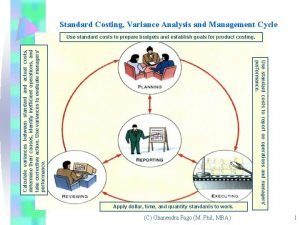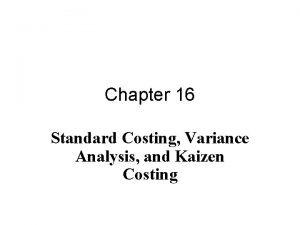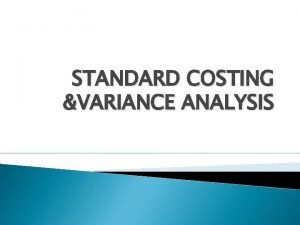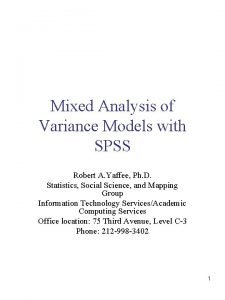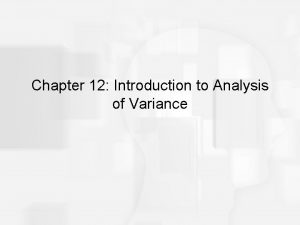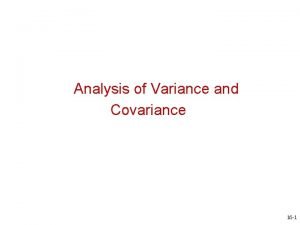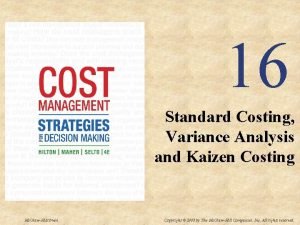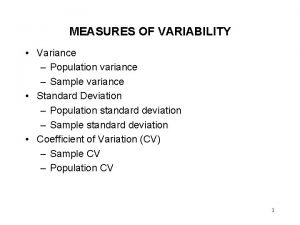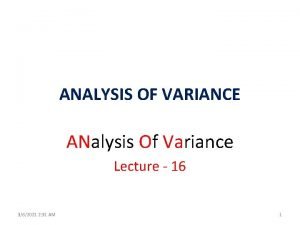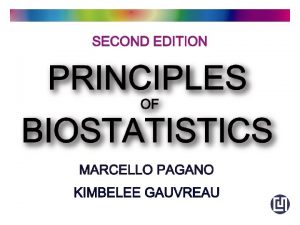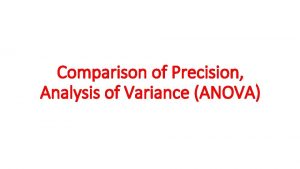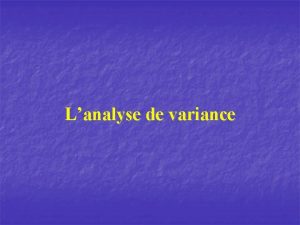Analysis of variance John W Worley Audio Group

























- Slides: 25

Analysis of variance John W. Worley Audio. Group, WCL Department of Electrical and Computer Engineering University of Patras, Greece http: //www. wcl. ee. upatras. gr/Audio. Group/

Hypothesis Null Hyp. (H 0) Exp. Hyp. (H 1) Experiment I. V. Data Nominal Type I Ordinal Interval Analysis Ratio Type II Modify Hyp. Slide 2 of 25

Data Analysis · Descriptive • Mean. • Standard error the mean (SEM). · Inferential statistics • t-test. – Related-means t-test. – Independent-means t-test. Univariate Analysis of Variance (ANOVA). · Multivariate ANOVA (MANOVA). · Slide 3 of 25

Small Variance µ 1 µ 2 Variance Slide 4 of 25

Large Variance µ 1 µ 2 Variance Slide 5 of 25

Small Variance µ 1 µ 2 P < 0. 05 Slide 6 of 25

Large Variance µ 1 µ 2 P > 0. 05 Slide 7 of 25

Errors in statistical decisions · Type I error: • Rejecting Null Hyp. when it’s true. · Type II error: • Retaining Null Hyp. when its false. Slide 8 of 25

Factorial design: Definitions · Factor is a categorical predictor variable • e. g. A treatment. · Level is amount of the factor. • e. g. the amount of treatment. · One-way ANOVA • One factor, multiple levels. · Two-way ANOVA • Two factors, different levels within the factors. Slide 9 of 25

ANOVA: Assumptions · Normal distributed data. • Histogram • Kolmogorov-Smirnov test • Shapiro-Wilk test Interval or ratio data. · Independence. · Homogeneity of variance. · • Levens test Slide 10 of 25

One-way, Between-Subjects Design: - One between groups factor (with 2 levels). Mnemonic aid YES Levels of Factor Mnemonic NO n 1 n 2 Subjects nn Slide 11 of 25

One-way, Within-subjects Design: - One within groups factor (with 3 levels) Memory recall with practise Day-1 Day-2 Levels of Factor Time Day-3 n 1 n 2 Subjects nn Slide 12 of 25

Mixed Design: - One between groups factor (with 2 levels). - One within groups factor (with 3 levels) Mnemonic aid YES Day-1 Day-2 Day-3 NO Levels of Factors Mnemonic Levels of Factors Time Day-1 Day-2 Day-3 n 1 n 2 Subjects nn Slide 13 of 25

Variable Interaction Story recall is improved by mnemonic aid and practice, with no interaction. · An interaction, practice has a greater effect upon recall with a mnemonic aid. · Slide 14 of 25

Post-hoc tests · Least-significant difference (LSD) pairwise comparison. • No Type I error control. · Studentized Newman-Keuls (SNK). • Liberal, no Type I error control. · Bonferroni Method. • Controls Type I error • Good when comparisons small. · Tukey Test • Controls Type I error • Good when comparisons large. Slide 15 of 25

MANOVA Memory recall with practise Levels of Factor Time Day-1 Day-2 Day-3 Confidence Comprehension n 1 Recall n 2 Subjects nn Slide 16 of 25

Multivariate analysis of variance (MANOVA) 2 -stage test · For more than one DV. · Avoids Type I error, with multiple ANOVA’s. · Detects differences among a combination of variables · Slide 17 of 25

MANOVA: Pre-requisites. · What DV’s: • Correlations*. • Discriminate function variates. · Assumptions: - Independence. Random sampling. Interval data Multivariate normality Equality of covariance F Leven’s test F Box’s test *Cole et al (1994) Psych. Bulletin, 115(3), 465 -474. Slide 18 of 25

MANOVA: Output Pillai-Bartlett Trace (V). · Wilk’s Lamda (Λ). · Hotelling’s T 2. · Roy’s Largest Root. · Slide 19 of 25

Distributions leptokurtic platykurtic Slide 20 of 25

MANOVA: Output Pillai-Bartlett Trace (V). · Wilk’s Lamda (Λ). · Hotelling’s T 2. · Roy’s Largest Root. · Slide 21 of 25

MANOVA: Follow-up analysis · If MANOVA sig. FANOVA • Type I error – Bonferroni correction FDiscriminant analysis Slide 22 of 25

Practical Considerations · Controls - Standardisation. F Instructions Practise/fatigue effects F Counterbalance conditions. F Randomise trial order. Within- or Between-subjects design? · For MANOVA: · - Choose DV’s theoretically Do Follow-up analysis. Experimentwise errors Slide 23 of 25

Conclusions · · · Identify your DV type. Within- or Between-subjects design. Control for everything. Report descriptive and inferential statistics. ANOVA is highly useful. MANOVA is logical progression. Follow-up analysis. F Bonferroni correction. F Slide 24 of 25

Audio. Group, WCL Department of Electrical and Computer Engineering University of Patras, Greece http: //www. wcl. ee. upatras. gr/Audio. Group/
 Cummings and worley change model
Cummings and worley change model Darryl worley have you forgotten
Darryl worley have you forgotten Tara worley
Tara worley Y = a(b)^x
Y = a(b)^x Rsq formula in standard costing
Rsq formula in standard costing Static budget variance example
Static budget variance example Variance analysis cycle
Variance analysis cycle The variance analysis cycle
The variance analysis cycle What are the advantages of flexible budget
What are the advantages of flexible budget Analysis of variance
Analysis of variance Variance analysis
Variance analysis Multivariate analysis of variance and covariance
Multivariate analysis of variance and covariance Manufacturing variance analysis
Manufacturing variance analysis Variance analysis meaning
Variance analysis meaning Spss mixed model
Spss mixed model Variance analysis in nursing
Variance analysis in nursing Flexible budget variance
Flexible budget variance Introduction to analysis of variance
Introduction to analysis of variance Analysis of variance and covariance
Analysis of variance and covariance Kaizen costing vs standard costing
Kaizen costing vs standard costing Material price variance
Material price variance Manufacturing cost variance analysis
Manufacturing cost variance analysis Variance analysis
Variance analysis Analysis of variance
Analysis of variance Susan is far superior to me in terms of technical knowledge
Susan is far superior to me in terms of technical knowledge Aggressive role
Aggressive role






